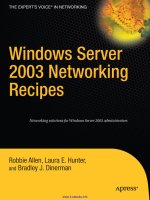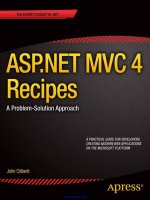Apress-Visual CSharp 2010 Recipes A Problem Solution Approach_5 ppt
Bạn đang xem bản rút gọn của tài liệu. Xem và tải ngay bản đầy đủ của tài liệu tại đây (1.99 MB, 95 trang )
CHAPTER 11 ■ SECURITY AND CRYPTOGRAPHY
545
■ Note CAS is deprecated in .NET 4.0.
How It Works
To minimize the security risks posed by malicious code, the runtime does not allow assemblies granted
only partial trust to access strongly named assemblies. This restriction dramatically reduces the
opportunity for malicious code to attack your system, but the reasoning behind such a heavy-handed
approach requires some explanation.
Assemblies that contain important functionality that is shared between multiple applications are
usually strongly named and are often installed in the Global Assembly Cache (GAC). This is particularly
true of the assemblies that constitute the .NET Framework class library. Other strongly named
assemblies from well-known and widely distributed products are in the GAC and accessible to managed
applications. The high chance that certain assemblies will be present in the GAC, their easy accessibility,
and their importance to many different applications make strongly named assemblies the most likely
target for any type of subversive activity by malicious managed code.
Generally, the code most likely to be malicious is that which is loaded from remote locations over
which you have little or no control (such as over the Internet). Under the default security policy of the
.NET Framework, all code run from the local machine has full trust, whereas code loaded from remote
locations has only partial trust. Stopping partially trusted code from accessing strongly named
assemblies means that partially trusted code has no opportunity to use the features of the assembly for
malicious purposes, and cannot probe and explore the assembly to find exploitable holes. Of course, this
theory hinges on the assumption that you correctly administer your security policy. If you simply assign
all code full trust, not only will any assembly be able to access your strongly named assembly, but the
code will also be able to access all of the functionality of the .NET Framework and even Win32 or any
COM object through P/Invoke and COM Interop. That would be a security disaster!
■ Note If you design, implement, and test your shared assembly correctly using CAS to restrict access to
important members, you do not need to impose a blanket restriction to prevent partially trusted code from using
your assembly. However, for an assembly of any significance, it’s impossible to prove there are no security holes
that malicious code can exploit. Therefore, you should carefully consider the need to allow partially trusted code to
access your strongly named assembly before applying
AllowPartiallyTrustedCallersAttribute. However, you
might have no choice. If you are exposing public classes that provide events, you must apply this attribute. If you
do not, an assembly that is not strongly named will be allowed to register a handler for one of your events, but
when it is called, a security exception will be thrown. Code in an assembly that is not strongly named is not
allowed to call code in a strongly named assembly.
The runtime stops partially trusted code from accessing strongly named assemblies by placing an
implicit LinkDemand for the FullTrust permission set on every public and protected member of every
publicly accessible type defined in the assembly. This means that only assemblies granted the
permissions equivalent to the FullTrust permission set are able to access the types and members from
CHAPTER 11 ■ SECURITY AND CRYPTOGRAPHY
546
the strongly named assembly. Applying AllowPartiallyTrustedCallersAttribute to your strongly
named assembly signals the runtime to not enforce the LinkDemand on the contained types and
members.
■ Note The runtime is responsible for enforcing the implicit LinkDemand security actions required to protect
strongly named assemblies. The C# assembler does not generate declarative LinkDemand statements at
compile time.
The Code
The following code fragment shows the application of the attribute
AllowPartiallyTrustedCallersAttribute. Notice that you must prefix the attribute with assembly: to
signal to the compiler that the target of the attribute is the assembly (also called a global attribute). In
addition, you do not need to include the Attribute part of the attribute name, although you can if you
want to add it. Because you target the assembly, the attribute must be positioned after any top-level
using statements, but before any namespace or type declarations.
using System.Security;
[assembly:AllowPartiallyTrustedCallers]
namespace Apress.VisualCSharpRecipes.Chapter11
{
public class Recipe11-01 {
// Implementation code . . .
}
}
■ Tip It's common practice to contain all global attributes in a file separate from the rest of your application code.
Microsoft Visual Studio uses this approach, creating a file named AssemblyInfo.cs to contain all global attributes.
Notes
If, after applying AllowPartiallyTrustedCallersAttribute to your assembly, you want to restrict
partially trusted code from calling only specific members, you should implement a LinkDemand for the
FullTrust permission set on the necessary members, as shown in the following code fragment:
CHAPTER 11 ■ SECURITY AND CRYPTOGRAPHY
547
[System.Security.Permissions.PermissionSetAttribute
(System.Security.Permissions.SecurityAction.LinkDemand, Name="FullTrust")]
public void SomeMethod() {
// Method code . . .
}
11-2. Disable Code Access Security
Problem
You need to turn off all CAS checks.
Solution
Use the Code Access Security Policy tool (Caspol.exe) and execute the command caspol -s off from the
command line to temporarily disable code access security checks.
■ Note This recipe only applies to .NET version 3.5 and earlier.
How It Works
Although CAS was implemented with performance in mind and has been used prudently throughout the
.NET class library, some overhead is associated with each security demand and resulting stack walk that
the runtime must execute to check every caller in the chain of execution.
You can temporarily disable CAS and remove the overhead and possible interference caused by
code-level security checks. Turning off CAS has the effect of giving all code the ability to perform any
action supported by the .NET Framework (equivalent to the FullTrust permission set). This includes the
ability to load other code, call native libraries, and use pointers to access memory directly.
Caspol.exe is a utility provided with the .NET Framework that allows you to configure all aspects of
your code access security policy from the command line. When you enter the command caspol -s off
from the command line, you will see the following message indicating that CAS has been temporarily
disabled:
Microsoft (r) .NET Framework CasPol 2.0.50727.42
Copyright (c) Microsoft Corporation. Al rights reserved.
CAS enforcement is being turned off temporarily. Press <enter> when you want to
restore the setting back on.
As the message states, CAS enforcement is off until you press Enter, or until the console in which
Caspol.exe is running terminates.
CHAPTER 11 ■ SECURITY AND CRYPTOGRAPHY
548
11-3. Disable Execution Permission Checks
Problem
You need to load assemblies at runtime without the runtime checking them for execution permission.
Solution
In code, set the property CheckExecutionRights of the class System.Security.SecurityManager to false
and persist the change by calling SecurityManager.SavePolicy. Alternatively, use the Code Access
Security Policy tool (Caspol.exe), and execute the command caspol -e off from the command line.
■ Note This recipe only applies to .NET version 3.5 and earlier.
How It Works
As the runtime loads each assembly, it ensures that the assembly’s grant set (the permissions assigned to
the assembly based on the security policy) includes the Execution element of SecurityPermission. The
runtime implements a lazy policy resolution process, meaning that the grant set of an assembly is not
calculated until the first time a security demand is made against the assembly. Not only does execution
permission checking force the runtime to check that every assembly has the execution permission, but it
also indirectly causes policy resolution for every assembly loaded, effectively negating the benefits of
lazy policy resolution. These factors can introduce a noticeable delay as assemblies are loaded,
especially when the runtime loads a number of assemblies together, as it does at application startup.
In many situations, simply allowing code to load and run is not a significant risk, as long as all other
important operations and resources are correctly secured using CAS and operating system security. The
SecurityManager class contains a set of static methods that provide access to critical security
functionality and data. This includes the CheckExecutionRights property, which turns on and off
execution permission checks.
To modify the value of CheckExecutionRights, your code must have the ControlPolicy element of
SecurityPermission. The change will affect the current process immediately, allowing you to load
assemblies at runtime without the runtime checking them for execution permission. However, the
change will not affect other existing processes. You must call the SavePolicy method to persist the
change to the Windows registry for it to affect new processes.
The Code
The following example contains two methods (ExecutionCheckOn and ExecutionCheckOff) that
demonstrate the code required to turn execution permission checks on and off and persist the
configuration change. You may need to run the example with administrator privileges.
CHAPTER 11 ■ SECURITY AND CRYPTOGRAPHY
549
using System;
using System.Security;
namespace Apress.VisualCSharpRecipes.Chapter11
{
class Recipe11_03
{
// A method to turn on execution permission checking
// and persist the change.
public void ExecutionCheckOn()
{
// Turn on execution permission checks.
SecurityManager.CheckExecutionRights = true;
// Persist the configuration change.
SecurityManager.SavePolicy();
}
// A method to turn off execution permission checking
// and persist the change.
public void ExecutionCheckOff()
{
// Turn off execution permission checks.
SecurityManager.CheckExecutionRights = false;
// Persist the configuration change.
SecurityManager.SavePolicy();
}
}
}
Notes
The .NET runtime allows you to turn off the automatic checks for execution permissions from within
code or by using Caspol.exe. When you enter the command caspol -e off or its counterpart caspol -e
on from the command line, the Caspol.exe utility actually sets the CheckExecutionRights property of the
SecurityManager class before calling SecurityManager.SavePolicy.
11-4. Ensure the Runtime Grants Specific Permissions to
Your Assembly
Problem
You need to ensure that the runtime grants your assembly those code access permissions that are critical
to the successful operation of your application.
CHAPTER 11 ■ SECURITY AND CRYPTOGRAPHY
550
Solution
In your assembly, use permission requests to specify the code access permissions that your assembly
must have. You declare permission requests using assembly-level code access permission attributes.
■ Note CAS is deprecated in .NET 4.0.
How It Works
The name permission request is a little misleading given that the runtime will never grant permissions to
an assembly unless security policy dictates that the assembly should have those permissions. However,
naming aside, permission requests serve an essential purpose, and although the way the runtime
handles permission requests might initially seem strange, the nature of CAS does not allow for any
obvious alternative.
Permission requests identify permissions that your code must have to function. For example, if you
wrote a movie player that your customers could use to download and view movies from your web server,
it would be disastrous if the user’s security policy did not allow your player to open a network
connection to your media server. Your player would load and run, but as soon as the user tried to
connect to your server to play a movie, the application would crash with the exception
System.Security.SecurityException. The solution is to include in your assembly a permission request
for the code access permission required to open a network connection to your server
(System.Net.WebPermission or System.Net.SocketPermission, depending on the type of connection you
need to open).
The runtime honors permission requests using the premise that it’s better that your code never load
than to load and fail sometime later when it tries to perform an action that it does not have permission
to perform. Therefore, if after security policy resolution the runtime determines that the grant set of your
assembly does not satisfy the assembly’s permission requests, the runtime will fail to load the assembly
and will instead throw the exception System.Security.Policy.PolicyException. Since your own code
failed to load, the runtime will handle this security exception during the assembly loading and transform
it into a System.IO.FileLoadException exception that will terminate your program.
When you try to load an assembly from within code (either automatically or manually), and the
loaded assembly contains permission requests that the security policy does not satisfy, the method you
use to load the assembly will throw a PolicyException exception, which you must handle appropriately.
To declare a permission request, you must use the attribute counterpart of the code access
permission that you need to request. All code access permissions have an attribute counterpart that you
use to construct declarative security statements, including permission requests. For example, the
attribute counterpart of SocketPermission is SocketPermissionAttribute, and the attribute counterpart
of WebPermission is WebPermissionAttribute. All permissions and their attribute counterparts follow the
same naming convention and are members of the same namespace.
When making a permission request, it’s important to remember the following:
• You must declare the permission request after any top-level using statements but
before any namespace or type declarations.
• The attribute must target the assembly, so you must prefix the attribute name with
assembly.
CHAPTER 11 ■ SECURITY AND CRYPTOGRAPHY
551
• You do not need to include the Attribute portion of an attribute’s name, although
you can.
• You must specify SecurityAction.RequestMinimum as the first positional argument
of the attribute. This value identifies the statement as a permission request.
• You must configure the attribute to represent the code access permission you
want to request using the attribute’s properties. Refer to the .NET Framework SDK
documentation for details of the properties implemented by each code access
security attribute.
• The permission request statements do not end with a semicolon (;).
• To make more than one permission request, simply include multiple permission
request statements.
The Code
The following example is a console application that includes two permission requests: one for
SocketPermission and the other for SecurityPermission. If you try to execute the
PermissionRequestExample application and your security policy does not grant the assembly the
requested permissions, you will get a PolicyException, and the application will not execute. Using the
default security policy, this will happen if you run the assembly from a network share, because
assemblies loaded from the intranet zone are not granted SocketPermission.
using System;
using System.Net;
using System.Security.Permissions;
// Permission request for a SocketPermission that allows the code to open
// a TCP connection to the specified host and port.
[assembly:SocketPermission(SecurityAction.RequestMinimum,
Access = "Connect", Host = "www.fabrikam.com",
Port = "3538", Transport = "Tcp")]
// Permission request for the UnmanagedCode element of SecurityPermission,
// which controls the code's ability to execute unmanaged code.
[assembly:SecurityPermission(SecurityAction.RequestMinimum,
UnmanagedCode = true)]
namespace Apress.VisualCSharpRecipes.Chapter11
{
class Recipe11_04
{
public static void Main()
{
// Do something . . .
CHAPTER 11 ■ SECURITY AND CRYPTOGRAPHY
552
// Wait to continue.
Console.WriteLine("Main method complete. Press Enter.");
Console.ReadLine();
}
}
}
11-5. Limit the Permissions Granted to Your Assembly
Problem
You need to restrict the code access permissions granted to your assembly, ensuring that people and
other software can never use your code as a mechanism through which to perform undesirable or
malicious actions.
Solution
Use declarative security statements to specify optional permission requests and permission refusal
requests in your assembly. Optional permission requests define the maximum set of permissions that
the runtime will grant to your assembly. Permission refusal requests specify particular permissions that
the runtime should not grant to your assembly.
■ Note CAS is deprecated in .NET 4.0.
How It Works
In the interest of security, it’s ideal if your code has only those code access permissions required to
perform its function. This minimizes the opportunities for people and other code to use your code to
carry out malicious or undesirable actions. The problem is that the runtime resolves an assembly’s
permissions using security policy, which a user or an administrator configures. Security policy could be
different in every location where your application is run, and you have no control over what permissions
the security policy assigns to your code.
CHAPTER 11 ■ SECURITY AND CRYPTOGRAPHY
553
Although you cannot control security policy in all locations where your code runs, the .NET
Framework provides two mechanisms through which you can reject permissions granted to your
assembly:
• Refuse request: This allows you to identify specific permissions that you do not
want the runtime to grant to your assembly. After policy resolution, if the final
grant set of an assembly contains any permission specified in a refuse request, the
runtime removes that permission.
• Optional permission request: This defines the maximum set of permissions that
the runtime can grant to your assembly. If the final grant set of an assembly
contains any permissions other than those specified in the optional permission
request, the runtime removes those permissions. Unlike as with a minimum
permission request (discussed in recipe 11-4), the runtime will not refuse to load
your assembly if it cannot grant all of the permissions specified in the optional
request.
You can think of a refuse request and an optional request as alternative ways to achieve the same
result. The approach you use depends on how many permissions you want to reject. If you want to reject
only a handful of permissions, a refuse request is easier to code. However, if you want to reject a large
number of permissions, it’s easier to code an optional request for the few permissions you want, which
will automatically reject the rest.
You include optional and refuse requests in your code using declarative security statements with the
same syntax as the minimum permission requests discussed in recipe 11-4. The only difference is the
value of the System.Security.Permissions.SecurityAction that you pass to the permission attribute’s
constructor. Use SecurityAction.RequestOptional to declare an optional permission request and
SecurityAction.RequestRefuse to declare a refuse request. As with minimal permission requests, you
must declare optional and refuse requests as global attributes by beginning the permission attribute
name with the prefix assembly. In addition, all requests must appear after any top-level using statements
but before any namespace or type declarations.
The Code
The code shown here demonstrates an optional permission request for the Internet permission set. The
Internet permission set is a named permission set defined by the default security policy. When the
runtime loads the example, it will not grant the assembly any permission that is not included within the
Internet permission set. (Consult the .NET Framework SDK documentation for details of the
permissions contained in the Internet permission set.)
using System.Security.Permissions;
[assembly:PermissionSet(SecurityAction.RequestOptional, Name = "Internet")]
namespace Apress.VisualCSharpRecipes.Chapter11
{
class Recipe11_05_OptionalRequest
{
// Class implementation . . .
}
}
CHAPTER 11 ■ SECURITY AND CRYPTOGRAPHY
554
In contrast to the preceding example, the following example uses a refuse request to single out the
permission System.Security.Permissions.FileIOPermission—representing write access to the C:
drive—for refusal.
using System.Security.Permissions;
[assembly:FileIOPermission(SecurityAction.RequestRefuse, Write = @"C:\")]
namespace Apress.VisualCSharpRecipes.Chapter11
{
class Recipe11_05_RefuseRequest
{
// Class implementation . . .
}
}
11-6. View the Permissions Required by an Assembly
Problem
You need to view the permissions that an assembly must be granted in order to run correctly.
Solution
Use the Permissions Calculator (Permcalc.exe) supplied with the .NET Framework SDK version 3.5 or
earlier.
■ Note CAS is deprecated in .NET 4.0.
How It Works
To configure security policy correctly, you need to know the code access permission requirements of the
assemblies you intend to run. This is true of both executable assemblies and libraries that you access
from your own applications. With libraries, it’s also important to know which permissions the assembly
refuses so that you do not try to use the library to perform a restricted action, which would result in a
System.Security.SecurityException exception.
The Permissions Calculator (Permcalc.exe) supplied with the .NET Framework SDK version
overcomes this limitation. Permcalc.exe walks through an assembly and provides an estimate of the
permissions the assembly requires to run, regardless of whether they are declarative or imperative.
CHAPTER 11 ■ SECURITY AND CRYPTOGRAPHY
555
The Code
The following example shows a class that declares a minimum, optional, and refusal request, as well as a
number of imperative security demands:
using System;
using System.Net;
using System.Security.Permissions;
// Minimum permission request for SocketPermission.
[assembly: SocketPermission(SecurityAction.RequestMinimum,
Unrestricted = true)]
// Optional permission request for IsolatedStorageFilePermission.
[assembly: IsolatedStorageFilePermission(SecurityAction.RequestOptional,
Unrestricted = true)]
// Refuse request for ReflectionPermission.
[assembly: ReflectionPermission(SecurityAction.RequestRefuse,
Unrestricted = true)]
namespace Apress.VisualCSharpRecipes.Chapter11
{
class Recipe11_06
{
public static void Main()
{
// Create and configure a FileIOPermission object that represents
// write access to the C:\Data folder.
FileIOPermission fileIOPerm =
new FileIOPermission(FileIOPermissionAccess.Write, @"C:\Data");
// Make the demand.
fileIOPerm.Demand();
// Do something . . .
// Wait to continue.
Console.WriteLine("Main method complete. Press Enter.");
Console.ReadLine();
}
}
}
CHAPTER 11 ■ SECURITY AND CRYPTOGRAPHY
556
Usage
Executing the command permview Recipe11-06.exe will generate the following output. Although this
output is not particularly user-friendly, you can decipher it to determine the declarative permission
requests made by an assembly. Each of the three types of permission requests—minimum, optional, and
refused—is listed under a separate heading and is structured as the XML representation of a
System.Security.PermissionSet object.
Microsoft (R) .NET Framework Permission Request Viewer.
Version 1.1.4322.573
Copyright (C) Microsoft Corporation 1998-2002. All rights reserved.
minimal permission set:
<PermissionSet class=System.Security.PermissionSet" version="1">
<IPermission class="System.Net.SocketPermission, System, Version=1.
0.5000.0, Culture=neutral, PublicKeyToken=b77a5c561934e089" version="
1" Unrestricted="true"/>
</PermissionSet>
optional permission set:
<PermissionSet class="System.Security.PermissionSet" version="1">
<IPermission class="System.Security.Permissions.IsolatedStorageFilePermission,
mscorlib, Version=1.0.5000.0, Culture=neutral, PublicKeyToken=b77a5c5
61934e089" version="1" Unrestricted="true"/>
</PermissionSet>
CHAPTER 11 ■ SECURITY AND CRYPTOGRAPHY
557
refused permission set:
<PermissionSet class="System.Security.PermissionSet" version="1">
<IPermission class="System.Security.Permissions.ReflectionPermission,
mscorlib, Version=1.0.5000.0, Culture=neutral, PublicKeyToken=b77a5c5
61934e089" version="1" Unrestricted="true"/>
</PermissionSet>
Executing the command permcalc -sandbox Recipe11-06.exe will generate a file named
sandbox.PermCalc.xml that contains XML representations of the permissions required by the assembly.
Where the exact requirements of a permission cannot be determined (because it is based on runtime
data), Permcalc.exe reports that unrestricted permissions of that type are required. You can instead
default to the Internet zone permissions using the -Internet flag. Here are the contents of
sandbox.PermCalc.xml when run against the sample code:
<?xml version="1.0"?>
<Sandbox>
<PermissionSet version="1" class="System.Security.PermissionSet">
<IPermission Write="C:\Data" version="1"
class="System.Security.Permissions.FileIOPermission, mscorlib,
Version=2.0.0.0, Culture=neutral,
PublicKeyToken=b77a5c561934e089" />
<IPermission version="1" class="System.Security.Permissions.SecurityPermission,
mscorlib, Version=2.0.0.0, Culture=neutral,
PublicKeyToken=b77a5c561934e089" Flags="Execution" />
<IPermission version="1" class="System.Security.Permissions.UIPermission,
mscorlib, Version=2.0.0.0, Culture=neutral,
PublicKeyToken=b77a5c561934e089" Unrestricted="true" />
CHAPTER 11 ■ SECURITY AND CRYPTOGRAPHY
558
<IPermission version="1" class="System.Net.SocketPermission, System,
Version=2.0.0.0, Culture=neutral, PublicKeyToken=b77a5c561934e089"
Unrestricted="true" />
</PermissionSet>
</Sandbox>
11-7. Determine at Runtime If Your Code Has a Specific
Permission
Problem
You need to determine at runtime if your assembly has a specific permission.
Solution
Instantiate and configure the permission you want to test for, and then pass it as an argument to the
static method IsGranted of the class System.Security.SecurityManager.
■ Note CAS is deprecated in .NET 4.0.
How It Works
Using minimum permission requests, you can ensure that the runtime grants your assembly a specified
set of permissions. As a result, when your code is running, you can safely assume that it has the
requested minimum permissions. However, you might want to implement opportunistic functionality
that your application offers only if the runtime grants your assembly appropriate permissions. This
approach is partially formalized using optional permission requests, which allow you to define a set of
permissions that your code could use if the security policy granted them, but are not essential for the
successful operation of your code. (Recipe 11-5 provides more details on using optional permission
requests.)
The problem with optional permission requests is that the runtime has no ability to communicate to
your assembly which of the requested optional permissions it has granted. You can try to use a protected
operation and fail gracefully if the call results in the exception System.Security.SecurityException.
However, it’s more efficient to determine in advance whether you have the necessary permissions. You
can then build logic into your code to avoid invoking secured members that will cause stack walks and
raise security exceptions.
CHAPTER 11 ■ SECURITY AND CRYPTOGRAPHY
559
■ Note IsGranted checks the grant set only of the calling assembly. It does not do a full stack walk to evaluate
the grant set of other assemblies on the call stack.
The Code
The following example demonstrates how to use the IsGranted method to determine if the assembly has
write permission to the directory C:\Data. You could make such a call each time you needed to test for
the permission, but it’s more efficient to use the returned Boolean value to set a configuration flag
indicating whether to allow users to save files.
using System.Security;
using System.Security.Permissions;
namespace Apress.VisualCSharpRecipes.Chapter11
{
class Recipe11_07
{
// Define a variable to indicate whether the assembly has write
// access to the C:\Data folder.
private bool canWrite = false;
public Recipe11_07()
{
// Create and configure a FileIOPermission object that represents
// write access to the C:\Data folder.
FileIOPermission fileIOPerm =
new FileIOPermission(FileIOPermissionAccess.Write, @"C:\Data");
// Test if the current assembly has the specified permission.
canWrite = SecurityManager.IsGranted(fileIOPerm);
}
}
}
11-8. Restrict Who Can Extend Your Classes and Override
Class Members
Problem
You need to control what code can extend your classes through inheritance and which class members a
derived class can override.
CHAPTER 11 ■ SECURITY AND CRYPTOGRAPHY
560
Solution
Use declarative security statements to apply SecurityAction.InheritanceDemand to the declarations of
the classes and members that you need to protect.
How It Works
Language modifiers such as sealed, public, private, and virtual give you a level of control over the
ability of classes to inherit from your class and override its members. However, these modifiers are
inflexible, providing no selectivity in restricting what code can extend a class or override its members.
For example, you might want to allow only code written by your company or department to extend
business-critical classes. By applying an InheritanceDemand attribute to your class or member
declaration, you can specify runtime permissions that a class must have to extend your class or override
particular members. Remember that the permissions of a class are the permissions of the assembly in
which the class is declared.
Although you can demand any permission or permission set in your InheritanceDemand, it’s more
common to demand identity permissions. Identity permissions represent evidence presented to the
runtime by an assembly. If an assembly presents certain types of evidence at load time, the runtime will
automatically assign the assembly the appropriate identity permission. Identity permissions allow you
to use regular imperative and declarative security statements to base security decisions directly on code
identity, without the need to evaluate evidence objects directly. Table 11-1 lists the type of identity
permission generated for each type of evidence. (Evidence types are members of the
System.Security.Policy namespace, and identity permission types are members of the
System.Security.Permissions namespace.)
Table 11-1. Evidence Classes That Generate Identity Permissions
Evidence Class Identity Permission
ApplicationDirectory
None
Hash
None
Publisher PublisherIdentityPermission
Site SiteIdentityPermission
StrongName StrongNameIdentityPermission
Url UrlIdentityPermission
Zone ZoneIdentityPermission
CHAPTER 11 ■ SECURITY AND CRYPTOGRAPHY
561
■ Note The runtime assigns identity permissions to an assembly based on the evidence presented by the
assembly. You cannot assign additional identity permissions to an assembly through the configuration of security
policy.
You must use declarative security syntax to implement an InheritanceDemand, and so you must use
the attribute counterpart of the permission class that you want to demand. All permission classes,
including InheritanceDemand, have an attribute counterpart that you use to construct declarative
security statements. For example, the attribute counterpart of PublisherIdentityPermission is
PublisherIdentityPermissionAttribute, and the attribute counterpart of StrongNameIdentityPermission
is StrongNameIdentityPermissionAttribute. All permissions and their attribute counterparts follow the
same naming convention and are members of the same namespace.
To control which code can extend your class, apply the InheritanceDemand to the class declaration
using one of the permissions listed in Table 11-1. To control which code can override specific members
of a class, apply the InheritanceDemand to the member declaration.
The Code
The following example demonstrates the use of an InheritanceDemand attribute on both a class and a
method. Applying a PublisherIdentityPermissionAttribute to the Recipe11_08 class means that only
classes in assemblies signed by the publisher certificate contained in the pubcert.cer file (or assemblies
granted FullTrust) can extend the class. The contents of the pubcert.cer file are read at compile time,
and the necessary certificate information is built into the assembly metadata. To demonstrate that other
permissions can also be used with an InheritanceDemand, the PermissionSetAttribute is used to allow
only classes granted the FullTrust permission set to override the method SomeProtectedMethod.
using System.Security.Permissions;
namespace Apress.VisualCSharpRecipes.Chapter11
{
[PublisherIdentityPermission(SecurityAction.InheritanceDemand,
CertFile = "pubcert.cer")]
public class Recipe11_08
{
[PermissionSet(SecurityAction.InheritanceDemand, Name="FullTrust")]
public void SomeProtectedMethod ()
{
// Method implementation . . .
}
}
}
CHAPTER 11 ■ SECURITY AND CRYPTOGRAPHY
562
11-9. Inspect an Assembly’s Evidence
Problem
You need to inspect the evidence that the runtime assigned to an assembly.
Solution
Obtain a System.Reflection.Assembly object that represents the assembly in which you are interested.
Get the System.Security.Policy.Evidence collection from the Evidence property of the Assembly object,
and access the contained evidence objects using the GetEnumerator, GetHostEnumerator, or
GetAssemblyEnumerator method of the Evidence class.
How It Works
The Evidence class represents a collection of evidence objects. The read-only Evidence property of the
Assembly class returns an Evidence collection object that contains all of the evidence objects that the
runtime assigned to the assembly as the assembly was loaded.
The Evidence class actually contains two collections, representing different types of evidence:
• Host evidence includes those evidence objects assigned to the assembly by the
runtime or the trusted code that loaded the assembly.
• Assembly evidence represents custom evidence objects embedded into the
assembly at build time.
The Evidence class implements three methods for enumerating the evidence objects it contains:
GetEnumerator, GetHostEnumerator, and GetAssemblyEnumerator. The GetHostEnumerator and
GetAssemblyEnumerator methods return a System.Collections.IEnumerator instance that enumerates
only those evidence objects from the appropriate collection. The GetEnumerator method returns an
IEnumerator instance that enumerates all of the evidence objects contained in the Evidence collection.
■ Note Evidence classes do not extend a standard base class or implement a standard interface. Therefore, when
working with evidence programmatically, you need to test the type of each object and know what particular types
you are seeking. (See recipe 3-11 for details on how to test the type of an object at runtime.)
The Code
The following example demonstrates how to display the host and assembly evidence of an assembly to
the console. The example relies on the fact that all standard evidence classes override the
Object.ToString method to display a useful representation of the evidence object’s state. Although
interesting, this example does not always show the evidence that an assembly would have when loaded
CHAPTER 11 ■ SECURITY AND CRYPTOGRAPHY
563
from within your program. The runtime host (such as the Microsoft ASP.NET or Internet Explorer
runtime host) is free to assign additional host evidence as it loads an assembly.
using System;
using System.Reflection;
using System.Collections;
using System.Security.Policy;
namespace Apress.VisualCSharpRecipes.Chapter11
{
public class Recipe11_09
{
public static void Main(string[] args)
{
// Load the specified assembly.
Assembly a = Assembly.LoadFrom(args[0]);
// Get the Evidence collection from the
// loaded assembly.
Evidence e = a.Evidence;
// Display the host evidence.
IEnumerator x = e.GetHostEnumerator();
Console.WriteLine("HOST EVIDENCE COLLECTION:");
while(x.MoveNext())
{
Console.WriteLine(x.Current.ToString());
Console.WriteLine("Press Enter to see next evidence.");
Console.ReadLine();
}
// Display the assembly evidence.
x = e.GetAssemblyEnumerator();
Console.WriteLine("ASSEMBLY EVIDENCE COLLECTION:");
while(x.MoveNext())
{
Console.WriteLine(x.Current.ToString());
Console.WriteLine("Press Enter to see next evidence.");
Console.ReadLine();
}
// Wait to continue.
Console.WriteLine("Main method complete. Press Enter.");
Console.ReadLine();
}
}
}
CHAPTER 11 ■ SECURITY AND CRYPTOGRAPHY
564
11-10. Determine If the Current User Is a Member of a
Specific Windows Group
Problem
You need to determine if the current user of your application is a member of a specific Windows user
group.
Solution
Obtain a System.Security.Principal.WindowsIdentity object representing the current Windows user
by calling the static method WindowsIdentity.GetCurrent. Create a System.Security.Principal.
WindowsPrincipal class using the WindowsIdentity class, and then call the method IsInRole of the
WindowsPrincipal object.
How It Works
The RBS mechanism of the .NET Framework abstracts the user-based security features of the underlying
operating system through the following two key interfaces:
• The System.Security.Principal.IIdentity interface, which represents the entity
on whose behalf code is running; for example, a user or service account.
• The System.Security.Principal.IPrincipal interface, which represents the
entity’s IIdentity and the set of roles to which the entity belongs. A role is simply
a categorization used to group entities with similar security capabilities, such as a
Windows user group.
To integrate RBS with Windows user security, the .NET Framework provides the following two
Windows-specific classes that implement the IIdentity and IPrincipal interfaces:
• System.Security.Principal.WindowsIdentity, which implements the IIdentity
interface and represents a Windows user.
• System.Security.Principal.WindowsPrincipal, which implements IPrincipal and
represents the set of Windows groups to which the user belongs.
Because .NET RBS is a generic solution designed to be platform-independent, you have no access to
the features and capabilities of the Windows user account through the IIdentity and IPrincipal
interfaces, and you must frequently use the WindowsIdentity and WindowsPrincipal objects directly.
To determine if the current user is a member of a specific Windows group, you must first call the
static method WindowsIdentity.GetCurrent. The GetCurrent method returns a WindowsIdentity object
that represents the Windows user on whose behalf the current thread is running. An overload of the
GetCurrent method takes a bool argument and allows you to control what is returned by GetCurrent if
the current thread is impersonating a user different from the one associated with the process. If the
argument is true, then GetCurrent returns a WindowsIdentity representing the impersonated user, and it
returns null if the thread is not impersonating a user. If the argument is false, then GetCurrent returns
CHAPTER 11 ■ SECURITY AND CRYPTOGRAPHY
565
the WindowsIdentity of the thread if it is not impersonating a user, and it returns the WindowsIdentity of
the process if the thread is currently impersonating a user.
■ Note The WindowsIdentity class provides overloaded constructors that, when running on Microsoft Windows
Server 2003 or later platforms, allow you to obtain a WindowsIdentity object representing a named user. You can
use this
WindowsIdentity object and the process described in this recipe to determine whether that user is a
member of a specific Windows group. If you try to use one of these constructors when running on an earlier
version of Windows, the
WindowsIdentity constructor will throw an exception. On Windows platforms preceding
Windows Server 2003, you must use native code to obtain a Windows access token representing the desired user.
You can then use this access token to instantiate a
WindowsIdentity object. Recipe 11-12 explains how to obtain
Windows access tokens for specific users.
Once you have a WindowsIdentity, instantiate a new WindowsPrincipal object, passing the
WindowsIdentity object as an argument to the constructor. Finally, call the IsInRole method of the
WindowsPrincipal object to test if the user is in a specific group (role). IsInRole returns true if the user is
a member of the specified group; otherwise, it returns false. The IsInRole method provides four
overloads:
• The first overload takes a string containing the name of the group for which you
want to test. The group name must be of the form [DomainName]\[GroupName] for
domain-based groups and [MachineName]\[GroupName] for locally defined groups.
If you want to test for membership of a standard Windows group, use the form
BUILTIN\[GroupName] or the other overload that takes a value from the
System.Security.Principal.WindowsBuiltInRole enumeration. IsInRole performs
a case-insensitive test for the specified group name.
• The second IsInRole overload accepts an int, which specifies a Windows role
identifier (RID). RIDs provide a mechanism that is independent of language and
localization to identify groups.
• The third IsInRole overload accepts a member of the
System.Security.Principal.WindowsBuiltInRole enumeration. The
WindowsBuiltInRole enumeration defines a set of members that represent each of
the built-in Windows groups.
• The fourth IsInRole overload accepts a
System.Security.Principal.SecurityIdentifier object that represents the
security identifier (SID) of the group for which you want to test.
Table 11-2 lists the name, RID, and WindowsBuiltInRole value for each of the standard Windows
groups.
CHAPTER 11 ■ SECURITY AND CRYPTOGRAPHY
566
Table 11-2. Windows Built-In Account Names and Identifiers
Account Name RID (Hex) WindowsBuiltInRole Value
BUILTIN\Account Operators 0x224 AccountOperator
BUILTIN\Administrators 0x220 Administrator
BUILTIN\Backup Operators 0x227 BackupOperator
BUILTIN\Guests 0x222 Guest
BUILTIN\Power Users 0x223 PowerUser
BUILTIN\Print Operators 0x226 PrintOperator
BUILTIN\Replicators 0x228 Replicator
BUILTIN\Server Operators 0x225 SystemOperator
BUILTIN\Users 0x221 User
■ Note Membership of the BUILTIN\Administrators group under Windows 7 will depend on the whether your
process is running with elevated privileges. If the current user is an administrator but your process is running
without elevated privileges, checking membership of
BUILTIN\Administrators will return false. See Chapter 14
for recipes relating to elevated privileges.
The Code
The following example demonstrates how to test whether the current user is a member of a set of named
“Windows groups.” You specify the groups that you want to test for as command-line arguments.
Remember to prefix the group name with the machine or domain name, or BUILTIN for standard
Windows groups.
using System;
using System.Security.Principal;
namespace Apress.VisualCSharpRecipes.Chapter11
{
class Recipe11_10
{
public static void Main (string[] args)
{
CHAPTER 11 ■ SECURITY AND CRYPTOGRAPHY
567
if (args.Length == 0)
{
Console.WriteLine(
"Please provide groups to check as command line arguments");
}
// Obtain a WindowsIdentity object representing the currently
// logged-on Windows user.
WindowsIdentity identity = WindowsIdentity.GetCurrent();
// Create a WindowsPrincipal object that represents the security
// capabilities of the specified WindowsIdentity; in this case,
// the Windows groups to which the current user belongs.
WindowsPrincipal principal = new WindowsPrincipal(identity);
// Iterate through the group names specified as command-line
// arguments and test to see if the current user is a member of
// each one.
foreach (string role in args)
{
Console.WriteLine("Is {0} a member of {1}? = {2}",
identity.Name, role, principal.IsInRole(role));
}
// Wait to continue.
Console.WriteLine("\nMain method complete. Press Enter.");
Console.ReadLine();
}
}
}
Usage
If you run this example as a user named Darryl on a computer named MACHINE using this command:
Recipe11-10 BUILTIN\Administrators BUILTIN\Users MACHINE\Accountants
you will see console output similar to the following:
Is MACHINE\Darryl a member of BUILTIN\Administrators? = False
Is MACHINE\Darryl a member of BUILTIN\Users? = True
Is MACHINE\Darryl a member of MACHINE\Accountants? = True
CHAPTER 11 ■ SECURITY AND CRYPTOGRAPHY
568
11-11. Restrict Which Users Can Execute Your Code
Problem
You need to restrict which users can execute elements of your code based on the user’s name or the roles
of which the user is a member.
Solution
Use the permission class System.Security.Permissions.PrincipalPermission and its attribute
counterpart System.Security.Permissions.PrincipalPermissionAttribute to protect your program
elements with RBS demands.
How It Works
The .NET Framework supports both imperative and declarative RBS demands. The class
PrincipalPermission provides support for imperative security statements, and its attribute counterpart
PrincipalPermissionAttribute provides support for declarative security statements. RBS demands use
the same syntax as CAS demands, but RBS demands specify the name the current user must have, or
more commonly, the roles of which the user must be a member. An RBS demand instructs the runtime
to look at the name and roles of the current user, and if that user does not meet the requirements of the
demand, the runtime throws a System.Security.SecurityException exception.
To make an imperative security demand, you must first create a PrincipalPermission object
specifying the username and role name you want to demand, and then you must call its Demand method.
You can specify only a single username and role name per demand. If either the username or the role
name is null, any value will satisfy the demand. Unlike with code access permissions, an RBS demand
does not result in a stack walk; the runtime evaluates only the username and roles of the current user.
To make a declarative security demand, you must annotate the class or member you want to protect
with a correctly configured PrincipalPermissionAttribute attribute. Class-level demands apply to all
members of the class, unless a member-specific demand overrides the class demand.
Generally, you are free to choose whether to implement imperative or declarative demands.
However, imperative security demands allow you to integrate RBS demands with code logic to achieve
more sophisticated demand behavior. In addition, if you do not know the role or usernames to demand
at compile time, you must use imperative demands. Declarative demands have the advantage that they
are separate from code logic and easier to identify. In addition, you can view declarative demands using
the Permview.exe tool (discussed in recipe 11-6). Whether you implement imperative or declarative
demands, you must ensure that the runtime has access to the name and roles for the current user to
evaluate the demand correctly.
The System.Threading.Thread class represents an operating system thread running managed code.
The static property CurrentPrincipal of the Thread class contains an IPrincipal instance representing
the user on whose behalf the managed thread is running. At the operating system level, each thread also
has an associated Windows access token, which represents the Windows account on whose behalf the
thread is running. The IPrincipal instance and the Windows access token are two separate entities.
Windows uses its access token to enforce operating system security, whereas the .NET runtime uses its
IPrincipal instance to evaluate application-level RBS demands. Although they may, and often do,
represent the same user, this is by no means always the case.
CHAPTER 11 ■ SECURITY AND CRYPTOGRAPHY
569
The benefit of this approach is that you can implement a user and an RBS model within your
application using a proprietary user accounts database, without the need for all users to have Windows
user accounts. This is a particularly useful approach in large-scale, publicly accessible Internet
applications.
By default, the Thread.CurrentPrincipal property is undefined. Because obtaining user-related
information can be time-consuming, and only a minority of applications use this information, the .NET
designers opted for lazy initialization of the CurrentPrincipal property. The first time code gets the
Thread.CurrentPrincipal property, the runtime assigns an IPrincipal instance to the property using the
following logic:
• If the application domain in which the current thread is executing has a default
principal, the runtime assigns this principal to the Thread.CurrentPrincipal
property. By default, application domains do not have default principals.
You can set the default principal of an application domain by calling the
SetThreadPrincipal method on a System.AppDomain object that represents the
application domain you want to configure. Code must have the ControlPrincipal
element of SecurityPermission to call SetThreadPrincipal. You can set the default
principal only once for each application domain; a second call to
SetThreadPrincipal results in the exception System.Security.Policy.
PolicyException.
• If the application domain does not have a default principal, the application
domain’s principal policy determines which IPrincipal implementation to create
and assign to Thread.CurrentPrincipal. To configure principal policy for an
application domain, obtain an AppDomain object that represents the application
domain and call the object’s SetPrincipalPolicy method. The
SetPrincipalPolicy method accepts a member of the enumeration
System.Security.Principal.PrincipalPolicy, which specifies the type of
IPrincipal object to assign to Thread.CurrentPrincipal. Code must have the
ControlPrincipal element of SecurityPermission to call SetPrincipalPolicy.
Table 11-3 lists the available PrincipalPolicy values; the default value is
UnauthenticatedPrincipal.
• If your code has the ControlPrincipal element of SecurityPermission, you can
instantiate your own IPrincipal object and assign it to the Thread.
CurrentPrincipal property directly. This will prevent the runtime from assigning
default IPrincipal objects or creating new ones based on principal policy.









